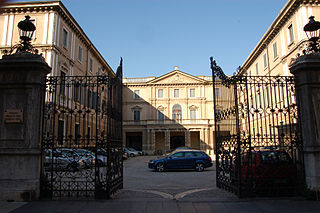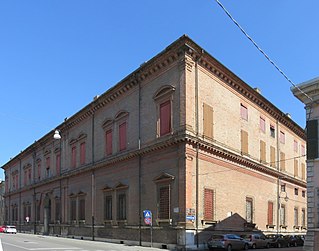
The Palazzo Sanvitale is a palace located on Piazzale Sanvitale #1 in central Parma, region of Emilia-Romagna, Italy. The palace now houses a museum.

The Palazzo Sanvitale is a palace located on Piazzale Sanvitale #1 in central Parma, region of Emilia-Romagna, Italy. The palace now houses a museum.
The palace has undergone a number of reconstructions. In the 18th century, the architect Angelo Rasori, reformulated the center facade in a Neoclassical-style, and built the entry staircase (scalone d'onore). The palace still retains some of the 19th-century interior decoration. In 1951 with the death of Giuseppe Sanvitale, the building was willed to an order of nuns. The palace now belongs to the Fondazione Monte Parma, and since 1999 houses the Museo Amedeo Bocchi focused on the 20th-century Parmesan painter. [1]

Parma is a city in the northern Italian region of Emilia-Romagna famous for its architecture, music, art, prosciutto (ham), cheese and surrounding countryside. It is home to the University of Parma, one of the oldest universities in the world. Parma is divided into two parts by the stream of the same name. The district on the far side of the river is Oltretorrente. Parma's Etruscan name was adapted by Romans to describe the round shield called Parma.

Museo di Capodimonte is an art museum located in the Palace of Capodimonte, a grand Bourbon palazzo in Naples, Italy. The museum is the prime repository of Neapolitan painting and decorative art, with several important works from other Italian schools of painting, and some important ancient Roman sculptures. It is one of the largest museums in Italy.

The Museo Lombardi is a museum displaying an eclectic collection of 19th-century art and cultural works from Parma. It is located in the Palazzo di Riserva on Strada Garibaldi #5 in central Parma, Emilia-Romagna, Italy.

The Rocca Sanvitale, or Sanvitale Castle, is a fortress residence in the centre of the town of Fontanellato, near Parma, northern Italy. Construction of the moated block, accessible through a drawbridge, was begun in the 13th century, mostly completed by the 15th century, with embellishments continuing through to the 18th century. It is prototypical of the urban castle-houses of the turbulent medieval communes of Northern Italy. Until the 1930s it was the home of the descendants of the Count of Sanvitale.

The Ducal Palace, also known as Reggia di Colorno, is an edifice in the territory of Colorno, Emilia Romagna, Italy. It was built by Francesco Farnese, Duke of Parma in the early 18th century on the remains of a former castle.

The Palazzo della Pilotta is a complex of edifices located between Piazzale della Pace and the Lungoparma in the historical centre of Parma, region of Emilia Romagna, Italy. Its name derives from the game of pelota played at one time by Spanish soldiers stationed in Parma.

The Palazzo Giustinian is a palace in Venice, northern Italy, situated in the Dorsoduro district and overlooking the Grand Canal next to Ca' Foscari. It is among the best examples of the late Venetian Gothic and was the final residence of Princess Louise of Artois.

Palazzo Pisani Moretta is a palace situated along the Grand Canal in Venice, Italy between Palazzo Tiepolo and Palazzo Barbarigo della Terrazza.

Piazza Mercanti is a central city square of Milan, Italy. It is located between Piazza del Duomo, which marks the centre of the modern city of Milan, and Piazza Cordusio, and it used to be the heart of the city in the Middle Ages. At the time, the square was larger than it is now and known as "Piazza del Broletto", after the "Broletto Nuovo", the palace that occupied the centre of the square. In the 13th century, there were six entry points to the square, each associated to a specific trade, from sword blacksmiths to hat makers.

The church of Sant'Antonio Abate is located in Parma, Italy.

The Palazzo Aldovrandi is a Senatorial palace on Via Galliera 8 in Bologna, built in Rococo style.

The Palazzo Giustinian Lolin is a Baroque style palace located on the Grand Canal of Venice, Italy. The present facade was designed circa 1630 by Baldassare Longhena. It is used as an exhibition venue for the Venice Biennale.

The San Quintino is a Renaissance style, Roman Catholic church located at Strada XXII Luglio number 21, near the intersection with Borgo Scacchini, in Parma, Italy.

The Palazzo Miniscalchi, adjacent to the 19th-century, Neoclassic style Palazzo Miniscalchi-Erizzo located on via Garibaldi, is a late-Gothic style palace with a facade on Via San Mamaso in central Verona, region of Veneto, Italy. The palace presently houses a museum and the Foundation for the Miniscalchi-Erizzo Museum. Access to the museum is through the Via San Mamaso entrance.

The Palazzo Cusani is an palace located on Piazzale San Francesco #1, in central Parma, region of Emilia-Romagna, Italy.

The Palazzo Massari, also known as the Palazzo Rosso, is a Renaissance-style palace located on Borso and Corso Porta Mare, at the northwest corner of Piazza Ariostea, in Ferrara, region of Emilia-Romagna, Italy.

The Palazzo di Riserva, also known as the Palazzo delle Poste because for long it hosted the offices of the Postal Service, is a Neoclassical-style palace in central Parma, region of Emilia Romagna, Italy. The large structure now hosts the Museo Glauco Lombardi displaying collections from 19th-century Parma, as well as offices of the postal service, the provincial forestry service, a literary club, and several shops. It has been much altered over the years.
Sanvitale is an Italian surname. It may refer to:

The Palazzo Fusconi-Pighini is a Renaissance-style palace located on Piazza Farnese #44 in the rione Regola of central Rome, Italy. The 16th-century palace also goes by the name of Pighini or Gallo di Roccagiovine. Today the palace houses various offices including the embassy of Cyprus.

The Palazzo del Giardino or Palazzo Ducale del Giardino is a historic palace in the Parco Ducale in Parma. It is not to be confused with the official Parma residence of Marie Louise, Duchess of Parma between Palazzo della Pilotta and Palazzo della Provincia in what is now known as piazzale della Pace - she also lived at the Ducal Palace of Colorno and in the Casino dei Boschi in Sala Baganza. The main Ducal Palace in Parma, the Palazzo della Pilotta and the teatro Reinach were all destroyed in bombing on 13 May 1944.
Coordinates: 44°48′5.73″N10°19′52.03″E / 44.8015917°N 10.3311194°E
| This article about a palace in Italy is a stub. You can help Wikipedia by expanding it. |